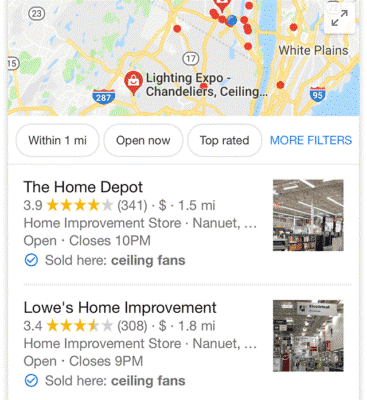The local pack is a section on Google’s SERP that shows the local businesses related to a searcher’s query. Whenever a query has local intent, Google will show the top 3 local businesses related to that intent. Companies can appear in the local pack if their Google My Business information is accurate and matches the searcher’s query.
Google recently launched a new “sold here” feature which will let searchers know whether the product they searched for is sold at the businesses featured in the local pack.
Search Engine Land did a great job of detailing the features of this update. Here, we give a quick summary and what the update may mean for Asia’s markets.
How does it work?
When a person searches for a particular product, Google may show a “sold here” label in the local pack description for the business or businesses that Google knows sell the item.
What does it look like?
Underneath the business name, star rating, description, and hours, Google will display a blue encircled checkmark with the label “sold here” preceding the product name.

Can searchers trigger the “sold here” label?
Google displays the “sold here” label only if it knows the product inventory of the business and only if the searcher’s query matches one of the inventory items.
How does a local store acquire the new “sold here” label?
Unfortunately, that’s not completely clear yet, explains Search Engine Land: “It may be pulling from the local inventory ads feature or it may look for customer reviews, Q&A, or website mentions.”
Does the “sold here” label benefit my business?
With just about anything in life, there are pros and cons. And we think that the “sold here” label is no different.
Pros
In the past, if you searched for a product, what would likely happen is that the big brands and ecommerce giants would win because normal SERPs generally prioritize bigger brands. The local pack, however, narrows the search based on location, giving smaller players like your local mom-and-pop stores more of a fighting chance if they can also clearly show inventory stock.
Additionally, the “sold here” label adds more text, colour, and bolding, which will hopefully make your result pop against the others and lead to higher conversions.
Cons
A big question, however, is how does Google know your inventory? One speculation is that they get this information based on product listing ads you’ve place, which makes the “sold here” label a bit of a pay-to-play feature, especially for smaller local stores.
The other speculated inventory data store is from user reviews, which makes sense but may be less structured and as a result may not be as reliable as a data source. Also, if number of reviews is a factor then again it would tend to favor bigger stores with more foot traffic.
What does the “sold here” label mean for the Asia market?
As usual, Google launches and tests features first in the US market. While we’ve tried to test the feature here, it does not yet seem visible in our local packs. We don’t know whether this is because Google doesn’t yet have inventory information on our local sellers or because Google has yet to release the feature in Hong Kong. But it’s often the case that new features don’t come to international markets right away, so it’s as expected to not yet see it here.
That said, it’s always helpful to keep an eye on what Google is launching and testing in the US so that we can prepare for the potential changes, challenges, and benefits we may see here.
Need help updating your Google My Business to appear in the local pack? Get in touch!



